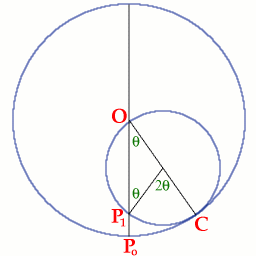Copyright © University of Cambridge. All rights reserved.
'Just Rolling Round' printed from https://nrich.maths.org/
Show menu
|
Tomas of Malmsbury School, Mark of The
British School of Manilla and Herbert of Sha Tin College, Hong Kong
sent good solutions to this problem. Well done all of
you.
$P$ is a point on the circumference of a circle radius $r$
which touches another circle radius $2r$ on the inside. The smaller
circle rolls, without slipping, around the inner circumference of
the larger circle.
The point $P$ is a fixed point on the smaller circle which
moves as the small circle moves. The point $P_o$ is the position of
$P$ when $P$ is at the point of contact between the two circles.
Consider the general position where the point of contact is the
point $C$ but here we do not assume that $P_1$ is the position of
the point $P$.
 |
By showing that the lengths of the arcs $P_oC$ and $P_1C$ are
equal, we shall prove that $P_1$ must be the position of the point
$P$ when the point of contact is at $C$. Hence we shall show that
$P$ must always lie on the diameter of the large circle through
$OP_o$.
Let $M$ be the centre of the small circle, then $MO = MP_1 =
MC = r$ and the triangle $OMP_1$ is isosceles. Hence $$\angle MOP_1
= \angle MP_1O = \theta$$ $$\angle P_1MC = \pi - (\pi - 2\theta) =
2\theta.$$ Hence, using the formula "arc length = radius x angle at
the centre of the circle": $$P_0C = (2r)(\theta) = 2r\theta$$ and
$$P_1C = (r)(2\theta) = 2r\theta.$$ Hence $P$ must be at the point
$P_1$ because the circle rolls without slipping, which shows that
the locus of P is the diameter of the larger circle.